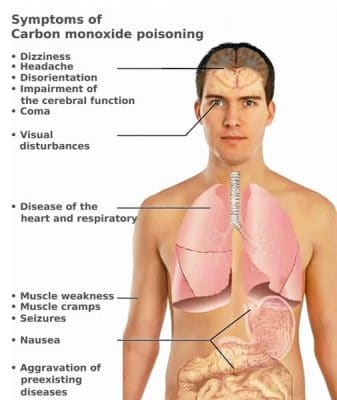Approximately 400 people die of carbon monoxide poisoning in the U.S. every year. This comes to at least 3 or 4 Utahns dying from carbon monoxide each year. Though the absolute numbers may seem small compared to other types of accidental death, this type of death is easily preventable, and there are steps you can take to reduce its likelihood. It is the most common cause of accidental poisoning.
Carbon dioxide, CO2, is what we all breathe out every day, and what plants use to photosynthesize. Carbon monoxide, with one rather than two oxygen molecules, may be colorless, odorless, and tasteless, but it is deadly. It is a byproduct of incomplete combustion, or burning of organic matter when there is not enough oxygen present.
The young and the elderly are particularly susceptible to carbon monoxide poisoning, as are pregnant women and those with pre-existing health problems, particularly asthma and low blood iron.
The first and most important step to preventing carbon monoxide deaths is to install a carbon monoxide detector and to check it regularly to make sure it is working order. Common emitters of carbon monoxide include small space heaters, kerosene and natural gas, and charcoal. Any old-fashioned, not-well-ventilated heater is prone to giving off carbon monoxide. Make sure any small heaters, barbecues, or vehicles are in a well-ventilated area. Car exhaust is a common cause of carbon monoxide poisoning, and is it vital to not leave vehicles idling in a garage, whether closed or open. Tobacco smoke, fires, and indoor cooking appliances (or those in a tent) also can cause carbon monoxide poisoning.
The symptoms of carbon monoxide poisoning may mimic other illnesses- dizziness, difficulty breathing, and nausea. More severe symptoms include irregular heartbeat, disorientation and confusion, chest pain, and blurry vision. If your child, grandparent, or spouse exhibit these symptoms, it is important to get the victim into fresh air, call 911, and administer CPR if the subject stops breathing.
To protect the most vulnerable – children and the elderly – there are steps you can take to improve carbon monoxide safety. Get your furnace and fireplace regularly checked. Don’t use space heaters in enclosed spaces like tents or cars. Take care with all appliances which rely on gas, from barbecues to generators.
Now that we are in the depths of winter, the risk for carbon monoxide poisoning goes up because people use heaters more. Additionally, the risk is greater at higher altitudes like Utah’s.
An eighteen-year-old Utah resident died of carbon monoxide poisoning in November. While visiting his girlfriend in Meridian, Idaho, McQuen Forbush, a Marine on leave, started to feel dizzy and unwell. His girlfriend also suffered the effects of the poisoning but eventually recovered. This tragic death illustrates that young people are indeed at higher risk of dying from the effects of carbon monoxide poisoning.
Utahns have wonderful recreational opportunities on our lakes and rivers, and camping in a houseboat on Lake Powell is a popular pastime. However, the risks of carbon monoxide poisoning from gasoline-powered generators is high: nine boaters died at Lake Powell due to carbon monoxide poisoning between 1994 and 2000, and 100 boaters suffered nonfatal illnesses due to CO exposure between 1990 and 2000. Those that fell ill were often swimming in the water near the engine. The most acute danger of carbon monoxide exposure is death, but dizziness, nausea, and disorientation are no laughing matter, especially when boating.
Carbon monoxide deaths are not consistent from year to year, however, it appears that Utah’s fatality rate is about double what might be otherwise expected from population. The combination of long, cold winters, high altitude, and use of natural gas engines in water recreation have led to spikes, such as the 18 deaths in 2005 (11 of those fire-related) and 12 in 2009 (none of which were fire-related).
Reducing your risk for carbon monoxide poisoning is inexpensive and easy: detectors can be bought at home improvement or grocery stores. Should you have any questions about how to protect you and your loved ones from carbon monoxide fatalities, contact Good Guys Injury Law for a FREE Accident Book.
Image courtesy: Intermedic hbo
